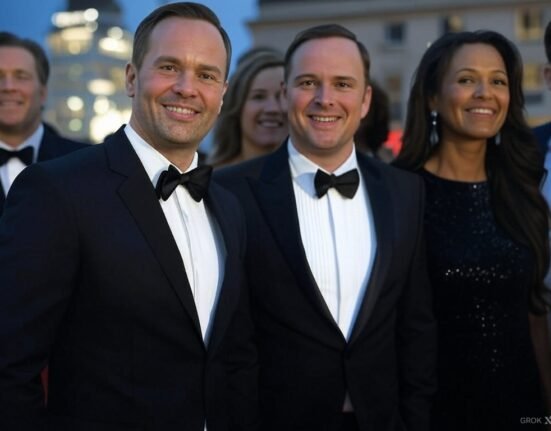The political landscape in France has recently been characterized by a series of challenges and controversies that have put President Emmanuel Macron under scrutiny. Since his election, Macron has navigated numerous domestic and international issues, but the current climate is particularly tumultuous, marked by widespread social discontent and political rivalries. Rising inflation and economic uncertainty have led to a growing sense of disillusionment among the French populace, reflected in protests and public demonstrations. These grievances have amplified calls for reform and fueled opposition from various political factions, challenging Macron’s administration on multiple fronts.
In addition to economic struggles, Macron has faced criticism for his approach to social policies and his government’s handling of ongoing issues such as immigration and security. These controversies have strained relations between the government and its constituents, fostering an environment where trust in public institutions is waning. As Macron seeks to maintain his position and achieve his political goals, he must contend with both external and internal pressures that threaten his authority and legislative agenda.
Moreover, the larger geopolitical context has added layers of complexity to Macron’s leadership. The war in Ukraine and its repercussions on European stability have placed the French president in a position of increasing prominence on the global stage. This combination of domestic and international challenges necessitates a strategic response that goes beyond traditional political approaches.
Amidst this backdrop, Macron’s decision to leverage the reopening of Notre Dame Cathedral serves as a pivotal moment, symbolizing resilience and unity during a period of division. By positioning this monumental event within his broader political strategy, Macron aims to transcend the current crises and reinvigorate national pride, thereby reinforcing his leadership in these turbulent times.
The Significance of Notre Dame Cathedral
Notre Dame Cathedral, a gothic architectural masterpiece situated in the heart of Paris, represents more than just a historical monument; it is a vital national symbol for France. Construction of the cathedral began in 1163 and was completed in 1345, making it an enduring emblem of French culture, religion, and history. This iconic structure has witnessed significant events throughout French history, from royal ceremonies to public gatherings. As such, it holds an esteemed position in the collective consciousness of the French populace.
The cathedral is renowned for its intricate sculptures, stunning stained glass windows, and the grandeur of its flying buttresses, attracting millions of tourists each year. Notre Dame not only serves as a site for religious services but also as a cultural beacon, reflecting the artistry and architectural innovation of its time. Its rich history and architectural beauty have engrained it deeply into the hearts of Parisians and visitors alike, making it a central point of national identity.
The recent fire that severely damaged Notre Dame in April 2019 marked a significant loss for both France and the international community. It underscored the delicate relationship between history and modernity and highlighted the importance of preservation in a rapidly changing world. The reopening of Notre Dame is of monumental significance; it not only represents the restoration of a cherished landmark but also symbolizes resilience and recovery following a devastating event. For citizens across France, the cathedral serves as a reminder of cultural pride and national unity, emphasizing the importance of collective efforts in safeguarding their heritage.
The reopening will undoubtedly reinvigorate tourism in Paris, contributing to the local economy and reinforcing Notre Dame’s status as an essential cultural site. As France navigates through contemporary challenges, the revival of Notre Dame stands as a testament to the enduring qualities of faith, resilience, and unity among the French people.
Macron’s Reaction to Political Challenges
President Emmanuel Macron has faced a myriad of political challenges during his tenure, characterized by public dissent, widespread protests, and significant economic issues. His administration has been consistently tested by the volatile socio-political landscape in France, which has been marked by demonstrations against proposed reforms and rising living costs. Such unrest has compelled Macron to adopt a multifaceted approach in addressing the grievances of the populace while attempting to preserve his political capital.
One significant challenge for Macron has been the ongoing protests stemming from pension reforms. The proposed changes have polarized public opinion, leading to unrest in cities across France. Despite the backlash, Macron has stood firm, illustrating his commitment to economic reforms aimed at sustaining France’s long-term growth. His determination, however, has not gone unnoticed, as approval ratings have fluctuated in response to these controversial policies. This precarious balance between reform and public satisfaction constitutes a substantial aspect of Macron’s political strategy.
Moreover, Macron has leveraged significant national milestones, such as the reopening of Notre Dame, to bolster his image and distract from the wave of protests. By intertwining cultural heritage with political motives, he seeks to remind the French public of national unity during turbulent times. The reopening served as a symbolic gesture of resilience, aiming to shift focus away from economic hardships and civil unrest. Yet, whether such strategies effectively enhance his political standing remains to be seen, particularly as public sentiment continues to ebb and flow in response to ongoing challenges.
In light of these circumstances, Macron’s administration is inevitably at a crossroads, where navigating public discontent while pushing for necessary reforms will define his legacy and political viability.
The Reopening of Notre Dame: A Symbol of Hope
The reopening of Notre Dame Cathedral is not merely an event; it is a beacon of hope for the French populace, symbolizing resilience and recovery following the devastating fire of April 2019. The cathedral, a masterpiece of Gothic architecture and a UNESCO World Heritage site, serves as a cultural and historical emblem, deeply embedded in the hearts of the French people. Its restoration has been a national endeavor, representing unity amidst various challenges faced by the nation.
As the carefully planned ceremonies approach, excitement and anticipation are palpable among the public. These ceremonies are designed not only to commemorate the cathedral’s reopening but also to reflect on the collective spirit of the community during these challenging times. The restoration effort, which has drawn international attention, underscores the dedication to preserving France’s historical legacy even in the face of adversity. The incorporation of modern restoration techniques alongside traditional craftsmanship highlights a balance between innovation and heritage.
Public sentiment has been overwhelmingly positive, with many expressing gratitude that this iconic monument is set to reopen its doors to visitors. The resumption of access to Notre Dame is expected to reignite tourism, contribute to economic recovery, and encourage cultural renewal within the city of Paris. The significance of this event cannot be overstated; it represents not just the return of a beloved landmark but also the rejuvenation of a city that has faced numerous trials, including the recent political climate marked by unrest and discontent.
It is clear that Notre Dame’s reopening will stand as a testament to the enduring spirit of the French nation. As communities come together to celebrate, the cathedral will once again be a place of reflection, gathering, and hope for all, reaffirming its role as a vital part of the nation’s identity.
How Macron Aims to Benefit Politically
President Emmanuel Macron’s strategic approach to the reopening of Notre Dame de Paris extends beyond its architectural significance; it serves as a prominent platform that he intends to utilize to enhance his political capital. Recognized not only as a national treasure of France, Notre Dame symbolizes cultural resilience, making it an ideal backdrop for Macron’s political ambitions. By aligning himself with this monumental event, he aims to evoke a sense of unity and national pride among the French populace.
One of the primary strategies likely employed by Macron involves leveraging media opportunities. The reopening ceremony can attract extensive coverage, allowing him to spotlight his administration’s achievements while highlighting continuity in governance. Macron’s engagement with the media during this period is likely to include public speeches emphasizing themes of renewal and hope, reinforcing his commitment to French heritage and values. In these addresses, he may draw parallels between the restoration of Notre Dame and the broader rejuvenation of France after recent political and social challenges.
Additionally, Macron is expected to reinforce his connection to national identity during the festivities surrounding the reopening. By positioning himself as a protector of France’s cultural assets, he seeks to solidify his image as a leader who is deeply invested in the country’s heritage. This strategy not only seeks to rally support from those who value national pride but also addresses disenchanted voters who may feel disconnected from the political establishment. As such, the reopening of Notre Dame serves as a pivotal moment for Macron, offering him an opportunity to respond to political challenges and rekindle public confidence in his leadership.
In summation, Macron’s political maneuvering surrounding the reopening of Notre Dame illustrates his intention to capitalize on national sentiments and reshape his standing in the political landscape, reinforcing the importance of cultural identity in contemporary governance.
Public Perception and Reactions
The reopening of Notre Dame has emerged as a significant political backdrop, particularly in the context of President Emmanuel Macron’s efforts to galvanize public support amid ongoing political challenges in France. The public’s perception of Macron’s strategic maneuvers surrounding this historical monument is multifaceted, eliciting a range of responses from various societal segments.
Supporters of Macron view the reopening of Notre Dame as a powerful symbol of national resilience and unity. For many, the cathedral is not merely an architectural treasure; it represents the enduring spirit of France. Macron’s framing of the reopening as a monumental achievement resonates strongly among those who believe in harnessing national pride, especially in a time when the country faces considerable political and social strife. This narrative fosters a sense of collective recovery, portraying Macron as a leader capable of guiding France toward renewal after the devastation wrought by the fire in 2019 and subsequent challenges.
Conversely, detractors argue that Macron’s actions reflect a calculated attempt at political opportunism. Critics contend that while the restoration project has its merits, it also serves as a convenient distraction from larger political issues, such as rising inflation and public discontent related to social policies. This perspective views the reopening of Notre Dame not as a genuine celebration of French culture but as a mere electioneering strategy aimed at securing favorable public opinion ahead of critical electoral periods.
Additionally, discussions around this topic often touch upon themes of nationalism and identity. While the cathedral is lauded as a cornerstone of French heritage, the politicization of its reopening raises questions about who benefits from such spectacles. Thus, public discourse continues to evolve as citizens grapple with the implications of Macron’s approach in leveraging Notre Dame for bolstering his political standing during turbulent times.
Historical Context: Previous Presidents and National Symbols
Throughout modern French history, the strategic use of national symbols by presidents has played a significant role in shaping political narratives and enhancing their public images. This phenomenon was particularly evident during critical periods of the French Republic, where leaders, facing political turbulence, turned to iconic national symbols to foster unity and rally public support. The utilization of cultural landmarks and events has often been a cornerstone for leaders aiming to reinforce their connection with the populace.
One notable example is President Charles de Gaulle, who, after World War II, leveraged France’s historical narrative and symbols to restore national pride and legitimacy. In his efforts to re-establish France’s global stature, de Gaulle frequently invoked the legacy of the French Revolution and engaged with sites like the Arc de Triomphe, which served as a powerful emblem of national unity and resilience. His addresses at these landmarks resonated deeply with citizens, thereby bolstering his political standing.
Similarly, François Mitterrand, during his presidency, undertook the transformative project of the Louvre Pyramid, symbolizing both cultural sophistication and modernity. By linking his administration to such a prominent cultural icon, Mitterrand positioned himself as a leader attuned to France’s rich heritage while also promoting a vision for progress. This strategic alignment with national symbols provided him with a platform to garner support during challenging political climates.
More recently, Nicolas Sarkozy’s initiatives in revitalizing the architecture of public spaces, such as the Palais de Tokyo, reflected his understanding of the power of national symbols in shaping political discourse. These actions served to both engage the public and frame his presidency in a favorable light amid economic difficulties. Such historical precedents illustrate the enduring significance of national symbols in the political landscape of France, setting a context for Emmanuel Macron’s recent strategy concerning the reopening of Notre Dame amidst current uncertainties.
Expert Opinions: Political Analysts Weigh In
The reopening of Notre Dame serves as a pivotal moment in Emmanuel Macron’s political strategy, particularly amidst the backdrop of ongoing political turbulence in France. Political analysts have highlighted various dimensions of this decision, emphasizing its symbolic and practical implications. Many experts assert that the cathedral’s reopening is not merely an architectural achievement; it is, in essence, a calculated maneuver to rally public sentiment and engage the French populace during a period marked by disillusionment with traditional politics.
According to Dr. Marie Leclerc, a renowned political scientist, Macron’s approach to the reopening reflects an adept understanding of national identity. “Notre Dame is a powerful emblem of French culture and history,” she states, “and its reopening can rekindle a sense of pride and unity among citizens.” Analysts believe that by associating his administration with this significant cultural landmark, Macron aims to fortify his political capital and counteract waning support.
Furthermore, political strategist Jean-Pierre Blanchard contends that the timing of the reopening is strategic. “As Macron faces heightened opposition from various factions, leveraging a national treasure such as Notre Dame can divert attention from political dissent,” he explains. This perspective suggests that the reopening could serve as a temporary reprieve from escalating grievances related to social policies and economic challenges.
Moreover, political commentators are observing the potential for Notre Dame’s reopening to reshape the public discourse surrounding Macron’s leadership. By prioritizing cultural restoration, Macron is positioning himself not only as a politician but also as a custodian of French heritage. This narrative could prove beneficial in solidifying his administrative agenda, especially as he approaches critical upcoming electoral challenges.
Conclusion: A Turning Point for Macron?
In examining the recent developments surrounding the reopening of Notre Dame, it is imperative to assess whether this significant cultural milestone can catalyze a transformative shift in President Emmanuel Macron’s political trajectory. The restoration of Notre Dame, a prominent symbol of national identity and historic architectural achievement, coincides with a period of considerable political strife for Macron. As the president grapples with various challenges, including economic recovery post-pandemic and increasing public dissent, the reopening of such an iconic site could provide an opportunity for rejuvenation.
First and foremost, the reopening ceremony serves as a moment of national unity, drawing attention away from the rampant divisions within French society. By framing the event as a triumph of resilience, Macron can promote a narrative that emphasizes recovery and hope, potentially rekindling public support. Furthermore, the juxtaposition of the rebuilding effort with the broader context of political upheaval might resonate with citizens who seek stable leadership amidst uncertainty. The transfer of national pride associated with Notre Dame could effectively bolster Macron’s image, helping him navigate through current political turbulence.
However, the question remains: can the reopening of Notre Dame truly serve as a turning point for Macron? While it may provide temporary relief from political woes, deep-seated issues requiring attention continue to loom over his administration. This moment presents both a challenge and an opportunity; will Macron leverage this pivotal event to address the broader discontent, or will it merely become a fleeting spectacle? Ultimately, the reopening may mark a crucial juncture for Macron, serving as a barometer for his ability to pivot away from controversy and toward a renewed sense of national purpose.













Leave feedback about this